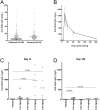Complete Removal of Extracellular IgG Antibodies in a Randomized Dose-Escalation Phase I Study with the Bacterial Enzyme IdeS--A Novel Therapeutic Opportunity
- PMID: 26177518
- PMCID: PMC4503742
- DOI: 10.1371/journal.pone.0132011
Complete Removal of Extracellular IgG Antibodies in a Randomized Dose-Escalation Phase I Study with the Bacterial Enzyme IdeS--A Novel Therapeutic Opportunity
Abstract
IdeS is a streptococcal protease that cleaves IgG antibodies into F(ab’)2 and Fc fragments with a unique degree of specificity, thereby providing a novel treatment opportunity of IgG-driven autoimmune conditions and antibody mediated transplant rejection. Here we report the results from a first in man, double blinded and randomized study with single ascending doses of IdeS in healthy, male subjects. Twenty healthy subjects were given intravenous single ascending doses of IdeS. With impressive efficacy IdeS cleaved the entire plasma IgG-pool only minutes after dosing. IgG reached nadir 6-24 hours after dosing and then slowly recovered. The half-life of IdeS was 4.9 (±2.8) hours at 0.24 mg/kg with the main fraction eliminated during 24 hours. Already two hours after IdeS-dosing, the phagocytic capacity of IgG/IgG-fragments was reduced to background levels. Importantly, IdeS has the capacity to inactivate Fc-mediated effector function in vivo, was considered safe with no serious adverse events, and without dose limiting toxicity in this study. The complete, rapid, but temporary removal of IgG provides a new potent therapeutic opportunity in IgG-mediated pathogenic conditions.
Trial registration: ClinicalTrials.gov NCT01802697.
Conflict of interest statement
Figures









References
-
- Carapetis JR, Steer AC, Mulholland EK, Weber M (2005) The global burden of group A streptococcal diseases. Lancet Infect Dis 5: 685–694. - PubMed
-
- Vincents B, von Pawel-Rammingen U, Björck L, Abrahamson M (2004) Enzymatic characterization of the streptococcal endopeptidase, IdeS, reveals that it is a cysteine protease with strict specificity for IgG cleavage due to exosite binding. Biochemistry 43: 15540–15549. - PubMed
Publication types
MeSH terms
Substances
Associated data
LinkOut - more resources
Full Text Sources
Other Literature Sources
Medical

